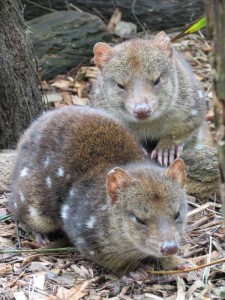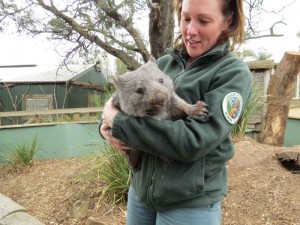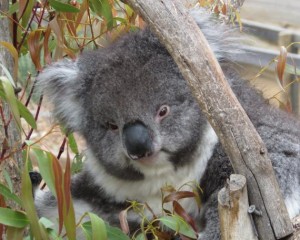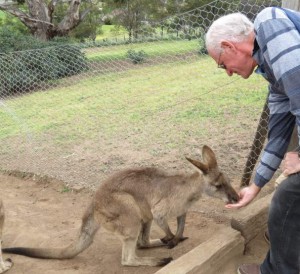More Bonorong
/ Birds were everywhere at Bonorong...not all in cages. Lorikeets, galahs and cockatoos squawked in the trees. Injured birds, like a blind tawny frogmouth, were caged, but the rest just stayed around of their own volition evidently appreciating a safe haven and a good food supply. A family of Cape Barren geese (labeled a “vulnerable” species) with five fluffy goslings waddled around, complaining a bit when we got too close. A wood duck couple tended their own flock of downy ducklings. A peacock (definitely not a native, but previously abandoned) wandered the grounds and regaled us with a full 360º tail feather display.
Birds were everywhere at Bonorong...not all in cages. Lorikeets, galahs and cockatoos squawked in the trees. Injured birds, like a blind tawny frogmouth, were caged, but the rest just stayed around of their own volition evidently appreciating a safe haven and a good food supply. A family of Cape Barren geese (labeled a “vulnerable” species) with five fluffy goslings waddled around, complaining a bit when we got too close. A wood duck couple tended their own flock of downy ducklings. A peacock (definitely not a native, but previously abandoned) wandered the grounds and regaled us with a full 360º tail feather display.

Mac, a staff member on his day off, chatted with us amiably as we approached the spotted quoll area. We'd never heard of quolls (other than a Scrabble word) before arriving in Australia. Another endangered species, these furry little marsupials are pretty amazing. About the size of a small, short-haired house cat with a long tail, they're very fierce predators and and can take down an animal the size of a wallaby by biting it in the back of the neck. We spotted three in the cage and Mac let us get some good photos since he was there. They looked cute enough from a distance. We had no urge to go into their cage after we saw one snarl.
 A staff-led tour introduced us to Digger the wombat. His mum was killed by a car. He survived in her pouch until he was rescued a few days later and brought to the sanctuary. He was bottle-fed, thrived and is now nearly a year old. I petted him. His fur is coarse like horsehair. He snuggled in the arms of the handler. As snuggly as he is now, we learned that when wombats reach maturity they are solitary and use their strong, cartilage-plated, armor-like back and sharp teeth to defend themselves against any would-be interlopers including sibs, parents and handlers.
A staff-led tour introduced us to Digger the wombat. His mum was killed by a car. He survived in her pouch until he was rescued a few days later and brought to the sanctuary. He was bottle-fed, thrived and is now nearly a year old. I petted him. His fur is coarse like horsehair. He snuggled in the arms of the handler. As snuggly as he is now, we learned that when wombats reach maturity they are solitary and use their strong, cartilage-plated, armor-like back and sharp teeth to defend themselves against any would-be interlopers including sibs, parents and handlers.
Next we visited a koala. We'd seen them in the wild in great numbers at Raymond Island, but always up a tree and we'd never touched one. They look so cute, soft and fuzzy … and they are. They have little tufts of fur on the tips of their ears and even their long-clawed paws are thickly furred. They look absolutely huggable, but I saw this apparently docile koala nip when the handler tried to remove her from a branch on which she clearly wanted to remain.
 A koala is not a bear, by the way, and we've been corrected several times on that misnomer. Koala is an aboriginal word meaning no water”. Since they're tree-dwellers and their diets consists of only eucalyptus leaves, they descend to land infrequently. They receive all of the water they need from the large quantities of these leaves they eat daily. Because the leaves lack nourishment, koalas eat lots and do not expend much energy. In fact, they spend 80% of their time sleeping. The males sound like snorting pigs when they vocalize which really spoils their whole fluffy, cuddly image.
A koala is not a bear, by the way, and we've been corrected several times on that misnomer. Koala is an aboriginal word meaning no water”. Since they're tree-dwellers and their diets consists of only eucalyptus leaves, they descend to land infrequently. They receive all of the water they need from the large quantities of these leaves they eat daily. Because the leaves lack nourishment, koalas eat lots and do not expend much energy. In fact, they spend 80% of their time sleeping. The males sound like snorting pigs when they vocalize which really spoils their whole fluffy, cuddly image.
The potoroos look ever so much like rats including a long, fur-less tail tipped in white. In actuality, they're the smallest member of the wallaby family and they definitely hop when they locomote. We saw one with her joey and another potoroo shadowed us around the perimeter of the cage. He followed every move we made and had that hang-dog look of a beggar ostensibly looking for a hand-out.
 We hand-fed Forester kangaroos and wallabies in a large enclosed paddock with the kanga-chow provided. We spotted a small shed with a terrarium outside of it. A lounge of lizards (yes, that's the correct collective noun unfortunately) crawling all over each other stared up at us with their yellow-brown reptilian eyes. They were blue-tongued lizards to be precise and other than seeing their eyes and blue tongues, it was hard to tell where one scaly lizard began and another left off. We did not request any petting time.
We hand-fed Forester kangaroos and wallabies in a large enclosed paddock with the kanga-chow provided. We spotted a small shed with a terrarium outside of it. A lounge of lizards (yes, that's the correct collective noun unfortunately) crawling all over each other stared up at us with their yellow-brown reptilian eyes. They were blue-tongued lizards to be precise and other than seeing their eyes and blue tongues, it was hard to tell where one scaly lizard began and another left off. We did not request any petting time.
Not all animals are available all the time at Bonorong. When injured animals are well, they're released. When the young are old enough to fend for themselves, they're released. So it was we did not see bandicoots or pandemelons, but I guess that's good. It means most of them are out there having fun in the bush.

